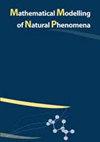Epicenter of Random Epidemic Spanning Trees on Finite Graphs
IF 2.1
4区 数学
Q2 MATHEMATICAL & COMPUTATIONAL BIOLOGY
引用次数: 0
Abstract
Epidemic source detection is the problem of identifying the network node that originated an epidemic from a partial observation of the epidemic process. The problem finds applications in different contexts, such as detecting the origin of rumors in online social media, and has been studied under various assumptions. Different from prior studies, this work considers an epidemic process on a finite graph that starts on a random node (epidemic source) and terminates when all nodes are infected, yielding a rooted and directed epidemic tree that encodes node infections. Assuming knowledge of the underlying graph and the undirected spanning tree, can the epidemic source be accurately identified? This work tackles this problem by introducing the epicenter , an efficient estimator for the epidemic source. When the underlying graph is vertex-transitive the epicenter can be computed in linear time and it coincides with the well-known distance center of the epidemic tree. Moreover, on a complete graph the epicenter is also the most likely estimator for the source. Finally, the accuracy of the epicenter is evaluated numerically on five different graph models and the performance strongly depends on the graph structure, varying from 31% (complete graphs) to 13% (sparse power law graphs).有限图上随机流行病生成树的震中
疫情源检测是通过对疫情过程的局部观测,识别出引起疫情的网络节点的问题。这个问题在不同的背景下得到了应用,比如在网络社交媒体中检测谣言的起源,并且在各种假设下进行了研究。与以往的研究不同,本工作考虑了一个有限图上的流行病过程,该过程从一个随机节点(流行病源)开始,并在所有节点都被感染时终止,从而产生了一个对节点感染进行编码的有根有向流行病树。假设已知底层图和无向生成树,能否准确识别疫情源?本文通过引入一种有效的传染源估计器——震中来解决这一问题。当底层图是顶点传递时,可以在线性时间内计算出震中,并且它与众所周知的流行病树的距离中心重合。此外,在一个完整的图上,震中也是最可能的震源估计值。最后,在五种不同的图模型上对震中的精度进行了数值评估,其性能强烈依赖于图结构,从31%(完全图)到13%(稀疏幂律图)不等。
本文章由计算机程序翻译,如有差异,请以英文原文为准。
求助全文
约1分钟内获得全文
求助全文
来源期刊

Mathematical Modelling of Natural Phenomena
MATHEMATICAL & COMPUTATIONAL BIOLOGY-MATHEMATICS, INTERDISCIPLINARY APPLICATIONS
CiteScore
5.20
自引率
0.00%
发文量
46
审稿时长
6-12 weeks
期刊介绍:
The Mathematical Modelling of Natural Phenomena (MMNP) is an international research journal, which publishes top-level original and review papers, short communications and proceedings on mathematical modelling in biology, medicine, chemistry, physics, and other areas. The scope of the journal is devoted to mathematical modelling with sufficiently advanced model, and the works studying mainly the existence and stability of stationary points of ODE systems are not considered. The scope of the journal also includes applied mathematics and mathematical analysis in the context of its applications to the real world problems. The journal is essentially functioning on the basis of topical issues representing active areas of research. Each topical issue has its own editorial board. The authors are invited to submit papers to the announced issues or to suggest new issues.
Journal publishes research articles and reviews within the whole field of mathematical modelling, and it will continue to provide information on the latest trends and developments in this ever-expanding subject.
 求助内容:
求助内容: 应助结果提醒方式:
应助结果提醒方式:


